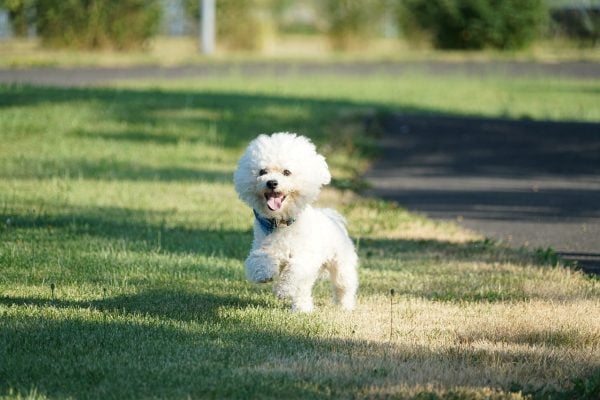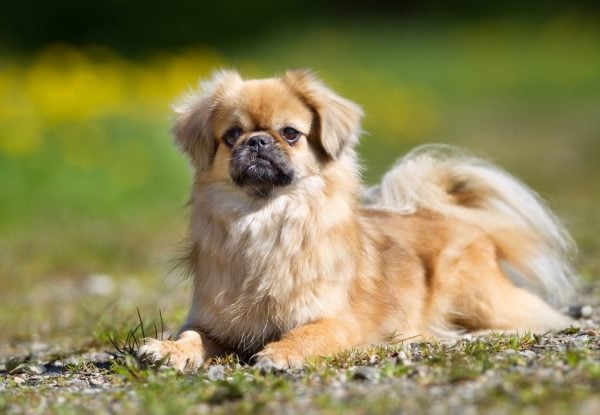- Not a substitute for professional veterinary help.
Unlike hunting hounds or herding breeds, lapdogs weren’t bred to work. These small dogs were bred to keep their people company. That’s why most lapdogs are small and generally less active than working dogs.
“A lapdog is typically defined as a dog small enough to lie down fully and comfortably in the lap of an average-size adult human sitting upright,” explains Katenna Jones, certified cat and dog behavior consultant, associate certified applied animal behaviorist, and Fear Free trainer at Jones Animal Behavior.
If you want a pup who loves to cuddle, read on for a list of 17 lapdog breeds who have warmed hearts—and laps—for centuries.
Bichon Frise
- Size: Small
- Weight: 12-18 lbs
- Lifespan: 14-15 years
- Personality: Playful, affectionate, sociable
- Grooming needs: Regular brushing and professional grooming
- Health: Generally healthy, but many have eye problems and dental issues
The Bichon Frise comes from the Mediterranean but became particularly beloved in the French royal courts. Aristocrats pampered their dogs, even carrying them around in baskets at times.
These dogs thrive with plenty of attention and do best in homes where they’re not left alone for long stretches. They need mental stimulation and daily play—otherwise, they may get a bit yappy or find mischief.
Biewer Terrier
- Size: Toy
- Weight: 4-8 lbs
- Lifespan: 12-15 years
- Personality: Cheerful, loyal, intelligent
- Grooming: High
- Health: Watch for dental issues
The Biewer Terrier (pronounced “beaver”) originated in Germany in the 1980s. This relatively new breed was bred purely as a companion dog and is known for its striking tricolor coat.
These people-oriented pups love to be near their humans and can become anxious when left alone for too long. They need gentle playtime and interaction, but they prefer lap lounging to athletics, which makes them a good choice for apartments and smaller homes.
Bolognese
- Size: Small
- Weight: 6-10 lbs
- Lifespan: 14-15 years
- Personality: Calm, devoted, intelligent
- Grooming needs: Moderate
- Health: Generally robust
The Bolognese comes from Bologna, Italy, where they have lived as companion dogs for centuries. During the Renaissance, Italian aristocrats gifted Bolognese dogs to foreign dignitaries.
This breed tends to form strong bonds with their people, and they thrive on companionship. They’re not overly energetic but need regular activity to stay happy and healthy. Short daily walks and mental stimulation can help prevent boredom and support their overall well-being.
Cavalier King Charles Spaniel
- Size: Toy
- Weight: 13-18 lbs
- Lifespan: 9-15 years
- Personality: Gentle, affectionate, adaptable
- Grooming needs: High
- Health: Prone to heart disease (mitral valve), eye conditions, and hip issues
The Cavalier King Charles Spaniel has a long history with English royalty. These dogs appear in many different portraits from the 17th and 18th centuries. King Charles II was so devoted to his spaniels that the breed carries his name.
Cavaliers are affectionate and eager to please, which makes training straightforward. They also enjoy short play sessions and cuddles, but they need companionship more than anything else—they don’t like to be left alone!
This breed tends to be very friendly with strangers, and Cavaliers also do well with kids, says Shaylin Ambrose, certified professional dog trainer and owner of Clever Tails Dog Training & Pet Sitting.
They’re particularly prone to mitral valve heart disease, so it’s important to search for a quality breeder.
Chihuahua
- Size: Toy
- Weight: 6 lbs or less
- Lifespan: 14-16 years
- Personality: Sassy, affectionate, loyal
- Grooming needs: Low to moderate
- Health: Prone to dental disease, heart problems, and luxating patellas
The Chihuahua is one of the oldest lapdog breeds in the Americas. People in ancient Aztec and Toltec civilizations kept them as comfort animals and believed they guided souls to the afterlife.
Though small, these dogs have big personalities and regularly appear on the list of most popular dog breeds in the U.S.
However, they can be fearful or wary of strangers if not socialized early, Ambrose says.
Dachshund
- Size: Small
- Weight: 13-32 lbs
- Lifespan: 12-16 years
- Personality: Feisty, clever, affectionate
- Grooming needs: Low to moderate, depending on coat type
- Health: Prone to back issues and dental disease
The Dachshund is another of the most popular breeds in the U.S. They originated in Germany as badger hunters, but their smaller size and affectionate natures have earned them a spot on many laps over the years.
They’re one of the most active lapdogs and benefit from moderate activity. That said, they’re prone to back issues like intervertebral disc disease (IVDD), which can be caused by excessive jumping and stairs.
Dachshunds love their people and thrive with regular attention—just like most lapdogs!
Italian Greyhound
- Size: Toy
- Weight: 7-14 lbs
- Lifespan: 14-15 years
- Personality: Gentle, affectionate, reserved
- Grooming needs: Very low
- Health: Prone to leg fractures, dental disease, and sensitivity to cold
The Italian Greyhound dates back to the Roman Empire, though the breed became especially adored in Renaissance Italy. Catherine the Great and Queen Victoria both had Italian Greyhounds, and these dogs sometimes appeared in royal portraits.
Despite having a similar sleek build to their Greyhound cousins, Italian Greyhounds are much smaller dogs bred more for snuggling than sprinting! They love lounging and lying around. However, they do need short bursts of activity and plenty of interaction.
Italian Greyhounds are known to be a delicate and sensitive breed that needs gentle handling. Don’t be surprised if yours is a little aloof with strangers.
Maltese
- Size: Toy
- Weight: Under 7 lbs
- Lifespan: 12-15 years
- Personality: Loving, lively, fearless
- Grooming needs: High
- Health: Prone to dental issues and obesity
The Maltese is one of the oldest lapdog breeds. Many people believe these dogs originated in ancient Malta, but they’re so old that no one knows exactly where they came from. Wealthy Roman and Greek women often carried these dogs as companions.
Maltese dogs bond tightly with their people. They won’t tolerate being ignored, so plan to give them plenty of attention. They also need consistent grooming to stay comfortable.
This breed makes a great lapdog, according to Dr. Suzanne Hetts, Certified Applied Animal Behaviorist Emeritus from Animal Behavior Associates. In her experience, Maltese dogs prefer relatively little activity and exercise.
Miniature Schnauzer
- Size: Small
- Weight: 11-20 lbs
- Lifespan: 12 years
- Personality: Friendly, alert, spirited
- Grooming needs: Moderate to high
- Health: Watch for dental disease, anal sac issues, and Schnauzer Comedone Syndrome
Originally bred in Germany as farm dogs and ratters, Miniature Schnauzers soon charmed their way into homes and onto laps as affectionate companions. Their size makes them a good fit for apartments and smaller homes without yards. They do well with people wanting a small dog who enjoys both activity and relaxation!
As Hetts explains, some breeds are miniature versions of highly active breeds, and smaller size doesn’t always mean lower exercise needs!
This breed is very intelligent, which means they need more mental stimulation and a regular routine. They thrive when they have a job to do, even if that job is regular training.
Pekingese
- Size: Toy
- Weight: 14 lbs or less
- Lifespan: 12-14 years
- Personality: Regal, independent, loyal
- Grooming needs: High
- Health: Prone to breathing issues, heat sensitivity, and eye injuries
Historians have found the Pekingese in Chinese records as far back as 200 BCE. These royal dogs were bred to warm the laps of emperors and their families.
“One breed whose history was to be quite sedate is the Pekingese, as at one time they were carried around in the sleeves of the robes of Chinese royalty,” Hetts says.
Today, they still enjoy calm environments and thrive with gentle companionship. They’re not high-energy but do need mental engagement, along with short walks and relaxed play sessions. Because they’re brachycephalic, they can be more prone to heatstroke in hot weather.
Pomeranian
- Size: Toy
- Weight: 3-7 lbs
- Lifespan: 12-16 years
- Personality: Bold, sassy, intelligent
- Grooming needs: High
- Health: Prone to dental issues, tracheal collapse, and knee problems
Pomeranians were bred down from much larger sled-pulling Spitz breeds. They hail from the Pomerania region of Europe, which now includes parts of Poland and Germany. Queen Victoria adored Pomeranians and helped popularize the smaller variety.
These fluffy dogs have big personalities despite their tiny bodies. Daily walks and short play sessions will help keep them entertained. They bond very closely with their pet parents, so they need plenty of attention—which they’ll let you know with plenty of sassy barks!
Ambrose says Pomeranians can be wary of strangers if not properly socialized. Enrollment in puppy classes will help your Pom grow confidence early on.
Pug
- Size: Toy
- Weight: 14-18 lbs
- Lifespan: 12-15 years
- Personality: Comedic, loving, social
- Grooming needs: Moderate
- Health: Prone to breathing concerns and overheating
Pugs have enjoyed plenty of popularity in recent years, but the breed is a very old one. Many experts believe they originated in China more than 2,000 years ago, when they were bred specifically as companions for royalty.
They’re happiest when with their people, so plan on giving them plenty of attention. These friendly dogs make great pets for seniors and anyone who spends a lot of time at home.
Due to their short snouts, they often have breathing problems and overheat easily, so it’s important to keep them cool in hot weather. Pay attention to food and treats, too, since obesity can make breathing problems worse.
Shih Tzu
- Size: Toy
- Weight: 9-16 lbs
- Lifespan: 10-16 years
- Personality: Sweet, dignified, cheerful
- Grooming needs: Very high
- Health: Prone to eye issues and breathing problems
Shih Tzus were bred in ancient China to resemble little lions. Meant to be ornamental and affectionate, they make wonderful lapdogs. If you’re a self-confessed couch potato looking for a fluffy companion, then the Shih Tzu may be a good fit.
They don’t need much exercise, but they do need mental engagement and company. You’ll often notice brown tear stains in this breed due to their facial structure, but you can use grooming wipes to keep them clean.
Tibetan Spaniel
- Size: Small
- Weight: 9-15 lbs
- Lifespan: 12-15 years
- Personality: Alert, playful, affectionate
- Grooming needs: Moderate
- Health: Generally healthy
This ancient spaniel was bred by Tibetan monks, who used them as lookouts as well as companions. Tibetan Spaniels would perch on walls to alert monks to intruders and spend the rest of the time curled up napping.
“While most people assume a lapdog should be friendly and sociable, historically many lapdogs were purposefully bred by the royalty whose laps they resided upon to have an increased alarm response related to potential threats, with an increased sensitivity and wariness of strangers,” Ambrose explains.
They can be a bit wary around strangers due to their history as alert dogs, but early socialization can help with this.
Early socialization happens most easily between 6-12 weeks of age, Hetts explains.
Yorkshire Terrier
- Size: Toy
- Weight: 7 lbs
- Lifespan: 12 – 15 years
- Personality: Feisty, affectionate, brave
- Grooming needs: High
- Health: Prone to eye issues and liver shunts
Yorkshire Terriers were originally bred to catch rats in English textile mills. They quickly climbed the social ladder and became lapdogs. Eventually, they developed into status symbols in Victorian households.
Despite their dainty size, Yorkies are known for their bravery. One example is Smoky, a WWII war dog. These dogs have a lot of tenacity packed into their tiny frames and can sometimes be a little stubborn. However, they love to be close to their dog parents.
Hetts explains that terriers can be lapdogs but often need more exercise than pups in the toy group. For help with exercise needs, consider finding a local dog walker or pet sitter in your area.
Papillon
- Size: Toy
- Weight: 3-9 lbs
- Lifespan: over 14 years
- Personality: Energetic, friendly, eager to please
- Grooming needs: Low to moderate
- Health: Generally healthy
Papillon means “butterfly” in French, and the Papillon gets its name from its large, butterfly-like ears. These tiny pups originated in France and Belgium, where they were bred as companion dogs for the European aristocracy.
Despite their dainty looks and small size, Papillons enjoy hunting and exploring. They have more energy than most of the other dogs on our list and have long life expectancies compared to other breeds. They thrive with plenty of play, training, and mental stimulation.
Miniature Pinscher
- Size: Toy
- Weight: 8-10 lbs
- Lifespan: 12-16 years
- Personality: Bold, energetic, fearless
- Grooming needs: Very low
- Health: Generally healthy
Despite what the name might suggest, the Mini Pinschers is not a miniature Doberman Pinscher. This German breed predates the Doberman and was bred to hunt vermin.
Their compact size earns them a spot on the lapdog list, but they’re generally more active than most lapdogs. They require plenty of daily walks and interactive play to keep them entertained. Otherwise, they can get into a lot of mischief. They’re also notorious escape artists, so make sure you have a GPS dog collar!
More About Teacup, Toy, and Mini Breeds
Terms like Teacup, Toy, and Miniature are often used to describe small dogs, but only Toy is recognized as an official breed group by the AKC.
- Miniature typically refers to a smaller version of the standard breed size, like the Miniature Schnauzer.
- Teacup is more of a marketing term. Dog breeders generally don’t use this term.
“Typically, dogs in the Toy category are the ones considered lapdogs,” Jones explains, adding that several smaller breeds from other categories can also fit the definition.
Of course, not every dog from a “lapdog” breed will be one!
“Every dog will have their own individual personality, formed largely by a combination of genetics and early life experiences. Some may just not enjoy cuddling or want to be a lapdog, regardless of general breed tendencies,” Ambrose explains.
Health needs
Dogs bred to be tiny can come with big health risks.
“Because they were bred over time to be smaller and smaller, many lapdogs have smaller bone density and a tighter nervous system that causes them to be more sensitive to sensory information,” Ambrose explains.
If you’re dreaming of a pocket-sized companion, start with a responsible breeder who health-tests their dogs and focuses on temperament, not trends. You don’t want to purchase from a breeder who emphasizes smallness over everything else.
Other Breeds To Consider
Love the idea of a lapdog but prefer a pup with a little more heft? Plenty of medium and large breeds have the snuggly, clingy personality associated with lapdogs.
A few larger breeds who often act like lapdogs include:
- Golden Retrievers: This friendly, people-loving breed is known for climbing into laps as if they’re still puppies.
- Labrador Retrievers: Labs are affectionate and easy to please, and they often lean on or into their people for comfort and connection.
- Great Dane: “Even the largest of dogs can ‘see themselves’ as lap dogs—just do a search and you’ll likely find Great Danes sitting in their owners’ laps,” Hetts says.
- Boxer: These goofy, loving dogs are always down to cuddle with their favorite person.
- Standard Poodle: Many Standard Poodles are velcro dogs who’ll happily lounge beside (or on) you.
- Newfoundland: Massive and mellow, Newfies are famously sweet and tend to act like overgrown teddy bears.
These dogs might not fit in a purse, but their hearts are just as big and many of them like to snuggle just as much.







